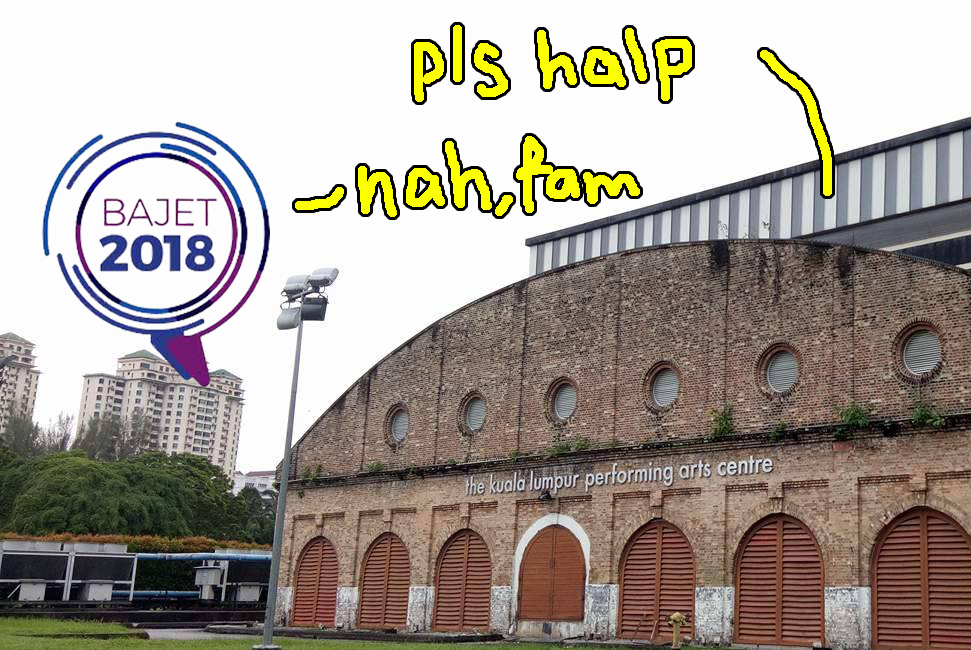3 sad reasons why KLPac, one of Msia’s biggest performing arts centre, might be closing down

- 4.0KShares
- Facebook3.8K
- Twitter11
- LinkedIn42
- Email27
- WhatsApp106
Sad news for all performing arts lovers: the Kuala Lumpur Performing Arts Centre (KLPac) might be taking their last bow! 🙁 For those of us who don’t live in KL (or those of us who just don’t care), KLPac is, well, a performing arts centre that opened its doors 12 years ago. So that’s 12 years of stage plays, workshops, film screenings… all of which might now come to an end!
Let’s be real- a lot of us don’t really care about it closing down. We probably don’t even know where it is (answer: Sentul #themoreyouknow). But I mean it’s one of the most established performing arts centres in Malaysia, and well, one of the very few that we’ve even heard about, really. And it’s one of those places that people just don’t visit, like museums and libraries. But if museums and libraries manage just fine, how come KLPac so kesian?
We spoke to the general manager of KLPac, as well as a few people who are involved in the performing arts scene who told us not only about what’s going on in KLPac itself, but helped us zoom out to see how the Malaysian performing arts scene looks like as a whole.
1. KLPac doesn’t earn a lot of money from what they do

On average, tickets for some of the shows in KLPac are about RM35-50, which is probably a lot more than what an average person would want to dole out for entertainment, what with movie tickets being about RM10-RM25 for a standard ticket. So from the get go itself, theatre isn’t quite high on the list when people decide where they want to go on Friday nights.
So you’d think that a couple of sold-out shows would be enough to sustain them, right? Well, that doesn’t get any further from the truth. Ticket sales, even if it’s a full house, usually only cover 40% of the production costs. You’d think that means KLPac gets that money, but KLPac’s general manager, Ian Chow, told us that this wasn’t true.
“We rent out our space to anyone who wants to do a show here. If the show is done by a production outside, then they get 100% of the profit– because they already paid us to rent our space. If KLPac itself does a show, then we profit. So our profit comes from rentals and our own shows.” – Ian

Which anyone who has an idea for the Next Big Show™ would have to come up with their own funds to run it, and whatever they get from ticket sales will go to them, so they might not even get all their money back. Meanwhile, in countries like the UK, it’s possible for budding young playbills to get funding from either the government or independent grants, but here, those opportunities are scarce.
But why doesn’t KLPac charge people bigger bucks for providing such a stellar theater space? Well, KLPac is actually a not-for-profit company because their heart is really just to support the local arts community. The Penang Performing Arts Centre (penangpac) is also a non-profit– which is why they don’t earn like a business would. Ian even told us that even though they charge more for corporates to rent out their space, they would still prioritise a production, even though they’d earn less! There is still good in this world :’)

Plus, theatre isn’t just homemade props and self-bought makeup. Considering the lights, sound systems, props, costumes and everything else that goes into running just one show, it can cost up to RM100,000 to get a show done! That’s a whole lot of money that KLPac might not get reimbursed. Ian told us how KLPac needs more money to run as the years pass.
“When we first opened, our equipment was new, everything was functioning well, so we rented out our stages for as little as RM500. Now what we have is a little bit older and it requires a little bit more maintenance, so our rent isn’t as low anymore.” – Ian
So generally, the theatre industry in itself earns enough to survive, but not necessarily to thrive. But thank goodness for donations… right?
2. Actually, nobody wants to give them money either
Here’s a bit of a look at the kind of money KLPac needs- their operational costs come to about RM3 MILLION annually! Just their utilities (think aircon and water bill) is already RM500,000 per year. So like any other non-profit organisation, KLPac would have to rely on donations and grants alongside the revenue they get from ticket sales.
But here’s the thing… The gomen hasn’t been the most supportive of the arts scene. When Budget 2018 was tabled close to a month ago, Ian told us that RM20 million was channeled to the Cultural Economy Development Agency (Cendana) only, and KLPac has had to write in to ask for funds. Think of all the performing arts centres in Malaysia (don’t forget the Malay, Chinese and Indian ones!) and how everyone can only get a small piece of that pie!

We spoke to Diong Chae Lian, who’s the co-founder of Gardner and Wife Theatre, an independent theatre that runs shows in PJ Live Arts in Petaling Jaya. She told us that even though the gomen does help out the arts, it’s… not much.
“The government allocates funding for arts & culture but most of it is used internally so there’s very little funding for activities by the private sector. We also don’t have cultural policies which take into account the country’s ethnic diversity nor acknowledge contemporary arts. Even our traditional arts are pigeon-holed and pre-Islamic art forms are also not recognised.” – Chae Lian
Ok, gomen dowan to help issokay. But what about big-time corporations, or companies who need to get their corporate social responsibility (CSR) done? Well, initially, KLPac had 12 sponsors, but in 2011 the number dropped to three. Ian told us that these sponsors are mostly international corporations because they see the value that the performing arts has in other countries.
Just to see how these corporations could profit, we only have to look at countries like the Philippines or Singapore, where Chae Lian tells us that most of our talent is going to because of stronger government support and more avenues to develop as an artist.

Besides not giving priority to the arts, Chae Lian told us how corporations just don’t see the arts as important 🙁
“One of the major difficulties with arts fundraising all over the world is persuading [corporate] donors that the arts is not purely entertainment. So when you compare donating to the arts vs orphans or animals, sentiment often lies with the latter.” – Chae Lian
But what does it mean to say that arts is not purely entertainment? Chae Lian told us that as a whole, theatre doesn’t just exist to entertain, but exists as a form of art, culture and even therapy! Despite it being something so important, not many people are super into theatre, which leads us to what’s probably the saddest reason we have on this list…
3. Not many people care much about theatre

This is probably something you already know judging from how much you care about theatre, but did you know that people who genuinely love theatre are sometimes also put off from theatre? Fa Abdul, a writer and director, told us that although some people might not hate theatre, but they just… don’t get it, you feel?
“When [Malaysians] hear of a theatre show and decide to finally check it out, they tend to compare theatre tickets with cinema – “I could bring my entire family to watch a movie in the cinema for the price of one theatre ticket!” You know what I mean? They do not know the effort that goes into the show.” – Fa
Without knowing the kind of effort that goes into a show (it’s no joke when people say it’s blood, sweat and tears), it’s not only hard for the performing arts industry to survive, but the people who are in it suffer as well. In fact, we once wrote an article comparing Malaysian theatre actors to fast food workers, and there wasn’t a whole lotta difference in whose job was better.

What is heartening is that there are people who are invested in the performing arts scene. With universities like Sunway, KDU and Aswara offering performing arts courses, there is no problem when it comes to us churning out young talent. But Ian told us that the issue is that no one’s actually going to watch the shows that these talents are producing.
“It’s supply and demand. The problem now is not supply- we have a lot of people graduating with performing arts degrees. But the problem is demand. Our shows usually hit 40-60% capacity… which is alright, but we can do a lot better than that.” – Ian
Ian also contrasted something as simple as getting off the train to illustrate just how much (or how little) we care about theatre.
“I lived in Belgium for a while. When you get off the train there, there are posters of the latest shows in the theatre, the ‘Now Playing’. But here? All you see are movie posters and probably a few advertisements.” – Ian
OMG it’s like there’s no hope for KLPac! How la?
Well, good news (ok kind of bad news also la) is that this isn’t the first time that this has happened– Ian told us that a similar financial crisis happened back in 2012, and that one was by far worse than what’s happening now! Also, the individuals and groups that KLPac owe money to are all pretty understanding and have given them time to settle their debts. So it’s not like… they’re closing down tomorrow or anything, and in Ian’s words, they ‘won’t go out without a fight’ 😉
But is KLPac –and theatre in general- forever going to struggle lidis? The truth is, we don’t know that. But what we do know is that everyone plays a part in keeping the performing arts alive, which is what Fa suggests:
“I believe those who love theatre are doing their bits. But we are just dust in the sky. While we try to reach out to others to fall in love and enjoy theatre like the rest of us, we need government and big corporations to give a hand to help the performing arts industry… until we reach the point where people value the performing arts and the wonders it does to the society, entities like KLPac need help from the big brothers.” – Fa

So at the end of the day, it’s really gotta take a village to raise this child we call performing arts, and it starts with us. We can donate to KLPac or watch a show… but really, what will save the industry is a change of mindsets, as Ian told us.
“People aren’t interested in the arts because they have a wrong mindset of what it is. People don’t want to spend on the arts. Down to our lifestyle, we’re just not exposed to arts like people in other countries are. So that is what needs to change.” – Ian
- 4.0KShares
- Facebook3.8K
- Twitter11
- LinkedIn42
- Email27
- WhatsApp106



